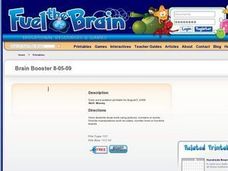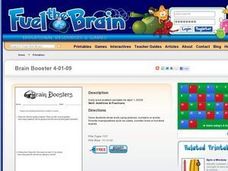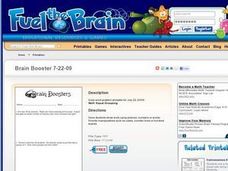Fuel the Brain
Pumpkin Concentration- Doubles Addition
This activity is print-out ready for when your learners need to practice doubles addition. A template provides the cards, which can be laminated and used throughout the year. Partners flip over cards to try and match the equation (1+1,...
Fuel the Brain
One Inch Scavenger Hunt
How many items can your learners find that are approximately one inch in length or width? Using this graphic organizer, they find nine, labeling and drawing each. A line that is 1-inch is provided at the bottom of the page, or you could...
Fuel the Brain
How Much Did They Spend?
Young learners do basic addition (with numbers between 50 and 323), to solve two short word problems. This is a great activity to start the day, or consider using this as a type of summative assessment.
Fuel the Brain
Brain Boosters - Add Ten on a Number Line
Encourage learners to use pictures, numbers, or words to solve two-word problems in which they count by 10's using a number line. They tell the total number of items the child has in each problem by starting at a given number and adding...
Fuel the Brain
Counting Money
How much money do the children in these word problems have? Through addition and subtraction with the help of visual representations drawn by your pupils, they will understand these skills better.
Fuel the Brain
Skill: Equal Grouping with Leftovers
Learning to complete word problems can be challenging, especially when the answers can contain leftovers. Through reading, solving, and illustrating each problem, your youngster will understand that answers can contain leftovers.
Fuel the Brain
Addition with Three Addends
Do you know how much of one activity that you did ALL day? Through addition, your learners will determine how much dancing and how much basketball Morgan and Anna did over the course of one day. They will have to create a number sentence...
Fuel the Brain
Addition
Addition is much more fun when you are finding the sum of different types of food! Your class will get hungry while solving these addition problems about hamburgers, hot dogs, and their condiments.
Fuel the Brain
Equal Grouping, Number of Groups & Number of Sets
Your class will enjoy solving and illustrating these word problems involving equal grouping of numbers and number sets. Your visual learners will benefit if you provide manipulatives or a hundreds board while solving.
Fuel the Brain
Comparing Numbers; Joining with No Regrouping
Your learners will know how solve word problems based on using coins. This skill will be important for the future so they can compare different coin values and how they add up, as well as how to join without regrouping.
Fuel the Brain
Subtraction
Give your class a fun St. Patrick's Day "brain booster." Keeping the holiday magic alive, your class will practice subtraction by determining how many clovers found had four leaves and how many coins out of the total "pot of gold" were...
Fuel the Brain
Fractions
Using problem stories that are meant for St. Patrick's day, your class will determine what fraction of shamrocks had four leaves and what fraction of pistachio pudding remains after people have been served.
Fuel the Brain
Interpret Pictographs
Have your youngsters use a graphic organizer and key to solve the following questions. By learning to interpret the pictographs, they will solve the problems accurately.
Fuel the Brain
Greatest and Least Word Problems
Your young learners are going to have to prove the answer for the greatest to least word problem. Using a chart for the second problem, your learners will have to use their mathematical terms to explain the solution.
Fuel the Brain
Turkey Day Dessert Double Venn w/ Questions
Your class will be able to read and understand information from a Venn Diagram with this fun activity. Different kinds of deserts are laid out in the graphic organizer and your class will be able to answer the following questions about...
Fuel the Brain
Separating
Using simple subtraction, your class will understand how to separate information that is given for the solution.
Fuel the Brain
Addition & Subtraction
Do your young learners know how to recognize a number if it is spelled out instead of being shown as numerals? They will solve two-digit and three-digit addition problems by recognizing the word and transferring that number into numerals.
Fuel the Brain
Addition & Fractions
Solve addition problems and problems involving fractions with ease! Your class will have a better grasp on these concepts after completing this 2 problem worksheet.
Fuel the Brain
Solve Problems by Making Hundreds
If your learners understand how to group in hundreds, this worksheet is a great way to practice this skill. The story problems ask how many groups of hundreds can be formed and if any are left over.
Fuel the Brain
Combine Fractions to Describe Parts of a Whole
If students don't finish their whole lunch one day, a fraction of it will remain. On a second day, if they don't finish their lunch, another fraction will remain. What is the sum of those fractions?
Fuel the Brain
Cupids Estimation
Learners use candied hearts to estimate how many will fill the heart on the Valentine's Day themed page. They then do a final count after they have finished the estimation activities.
Fuel the Brain
Joining by Tens
Used as a warm-up or exit ticket, your class will enjoy solving problems about dinosaurs and blocks. Adding 10 to any number may be tricky, so allow your learners to use manipulatives or draw on the worksheet itself!
Fuel the Brain
Joining (Addition) - Result Unknown
Are two, three, and four digit word problems tricky for your learners in your classroom? This practice will help your young mathematicians use addition and show their work in the space provided using regrouping when necessary.
Fuel the Brain
Equal Grouping
Using division can be challenging for some young learners. However, these problems that are simple division without remainders, are designed to help your learners both conceptualize and visualize the problem before solving.

























